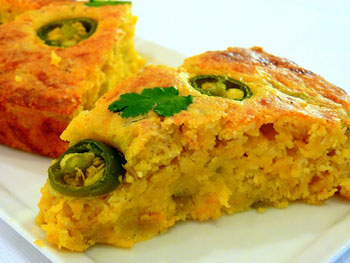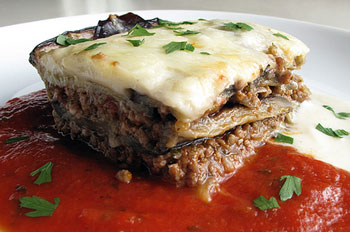 If you are planning a Cinco de Mayo feast, you are going to need a satisfying side dish to accompany your meal. A Savory Mexican Cornbread is the perfect canvas for sopping up the sauce. And for those of you who can't have your food touching (you know who you are) it's okay to keep it on a separate plate.
If you are planning a Cinco de Mayo feast, you are going to need a satisfying side dish to accompany your meal. A Savory Mexican Cornbread is the perfect canvas for sopping up the sauce. And for those of you who can't have your food touching (you know who you are) it's okay to keep it on a separate plate.
This cornbread does not have a dense, hockey puck-like consistency. Instead it is cakey and very moist. Void of any overwhelming flavor, it makes the perfect sidekick for an already flavorful meal. It melds nicely.
I know lots of people stick with their Jiffy cornbread from a box but this has such a better consistency and does not take much effort to put together. If you are like me and enjoy your cornbread sweet, butter and honey are a stunning addition to each slice. You must try it.

 Panko crusted fish tacos, with a Chipotle-Lime Mayo and Chipotle Spiced Corn....sheer yumminess. Best of all was the Wild Alaskan Halibut I received from the
Panko crusted fish tacos, with a Chipotle-Lime Mayo and Chipotle Spiced Corn....sheer yumminess. Best of all was the Wild Alaskan Halibut I received from the  “Foodie” vacations are usually to countries like France, Italy or China. But Jamaica? Sun, surf, music and, dare we forget, ganja, of course, but food? So how fabulous to find it is also a haven for some mighty fine dining.
“Foodie” vacations are usually to countries like France, Italy or China. But Jamaica? Sun, surf, music and, dare we forget, ganja, of course, but food? So how fabulous to find it is also a haven for some mighty fine dining. Corn tortillas come in such huge bags, I don't know how can you possibly use them all. Buying one of those packages, though they are cheap, is a major commitment in my house. It means weeks of enchiladas, tacos, chilaquiles and when I run out of ideas, tortilla chips or totopos as they are known in Mexico. I love the word totopos, even though it sounds a bit too much like the Italian name of a certain well-known cartoon mouse.
Corn tortillas come in such huge bags, I don't know how can you possibly use them all. Buying one of those packages, though they are cheap, is a major commitment in my house. It means weeks of enchiladas, tacos, chilaquiles and when I run out of ideas, tortilla chips or totopos as they are known in Mexico. I love the word totopos, even though it sounds a bit too much like the Italian name of a certain well-known cartoon mouse.  "It's all Greek to me" were practically the words that came out of my
mouth when I first saw this dish listed on a restaurant menu. I didn't
know what I was getting in to, but ever since that initial sumptuous
taste, I have been in love and obsessed with this classic Greek
casserole. Moussaka at first may appear to be a wintry meal, but late
summer with its abundance of dark purple eggplants or aubergines is
truly the perfect opportunity for making this dish. For me the sight of
an eggplant around this time of year automatically equals moussaka. And
truth be told, I love it so much that I usually end up eating the
entire casserole all by myself.
"It's all Greek to me" were practically the words that came out of my
mouth when I first saw this dish listed on a restaurant menu. I didn't
know what I was getting in to, but ever since that initial sumptuous
taste, I have been in love and obsessed with this classic Greek
casserole. Moussaka at first may appear to be a wintry meal, but late
summer with its abundance of dark purple eggplants or aubergines is
truly the perfect opportunity for making this dish. For me the sight of
an eggplant around this time of year automatically equals moussaka. And
truth be told, I love it so much that I usually end up eating the
entire casserole all by myself.